Abstract
OBJECTIVE--To assess the factors associated with cessation of smoking with transdermal nicotine and brief behavioural counselling. DESIGN--Interviews, treatment, and follow up for 26 weeks. SUBJECTS--1481 subjects recruited by mass media publicity who smoked > or = 15 cigarettes a day and were motivated to stop smoking. INTERVENTIONS--Twelve weeks' treatment with transdermal nicotine and brief behavioural counselling at monthly visits. MAIN OUTCOME MEASURE--Sustained smoking cessation for the 28 days before the visit at week 26 verified by expired carbon monoxide concentrations. The logistic regression analysis included all subjects. RESULTS--Most subjects were dependent on nicotine, and the mean (SD) number of cigarettes smoked a day was 32 (12). Overall, 316/1481 subjects (21.3%) stopped smoking. Factors associated with stopping were being male (adjusted odds ratio 2.0; 95% confidence interval 1.5 to 2.7), age > or = 40 years (1.5; 1.1 to 2.0), living with a spouse or partner (1.5; 1.1 to 2.1), motivation ("want to quit" 1.7; 1.2 to 2.3), and concern about weight gain (1.7; 1.3 to 2.2). Negative associations were smoking marijuana (0.4; 0.2 to 0.8) and the presence of other smokers in the household (0.8; 0.6 to 0.9). Almost all subjects who smoked three or more cigarettes in the first four weeks of treatment resumed smoking in the long term (525/547, 96%). CONCLUSIONS--Age, sex, marital status (living with a spouse or partner), motivation, concern about weight gain, recent marijuana smoking, and other smokers in the household were baseline factors associated with differences in outcome of smoking cessation attempts. Smoking three or more cigarettes in the first few weeks after stopping strongly predicted long term relapse.
Full text
PDF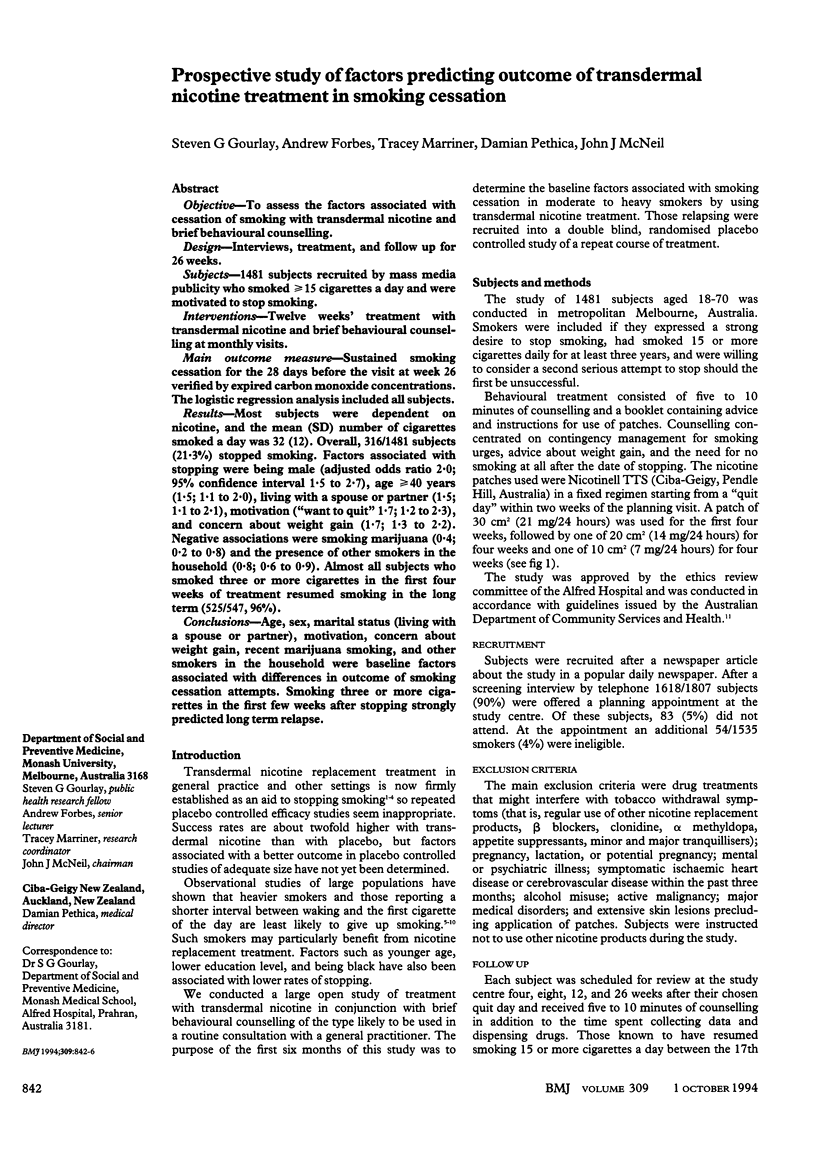
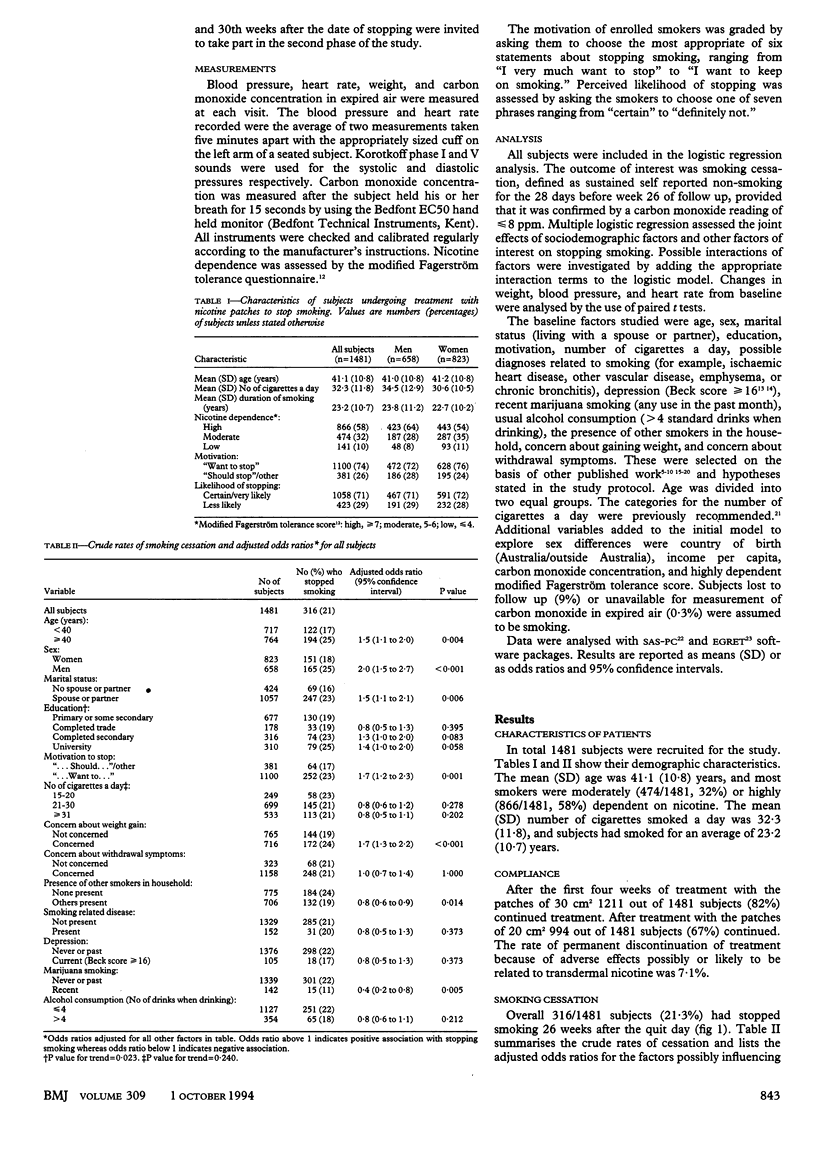
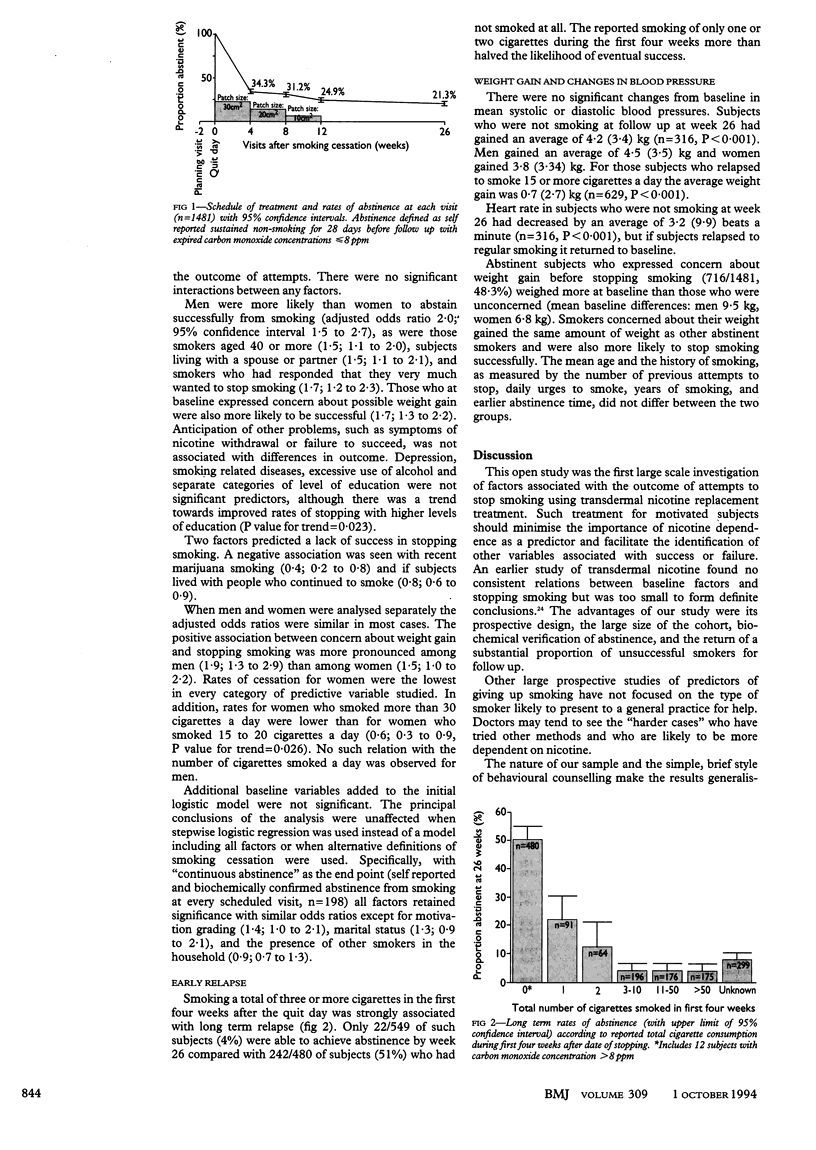
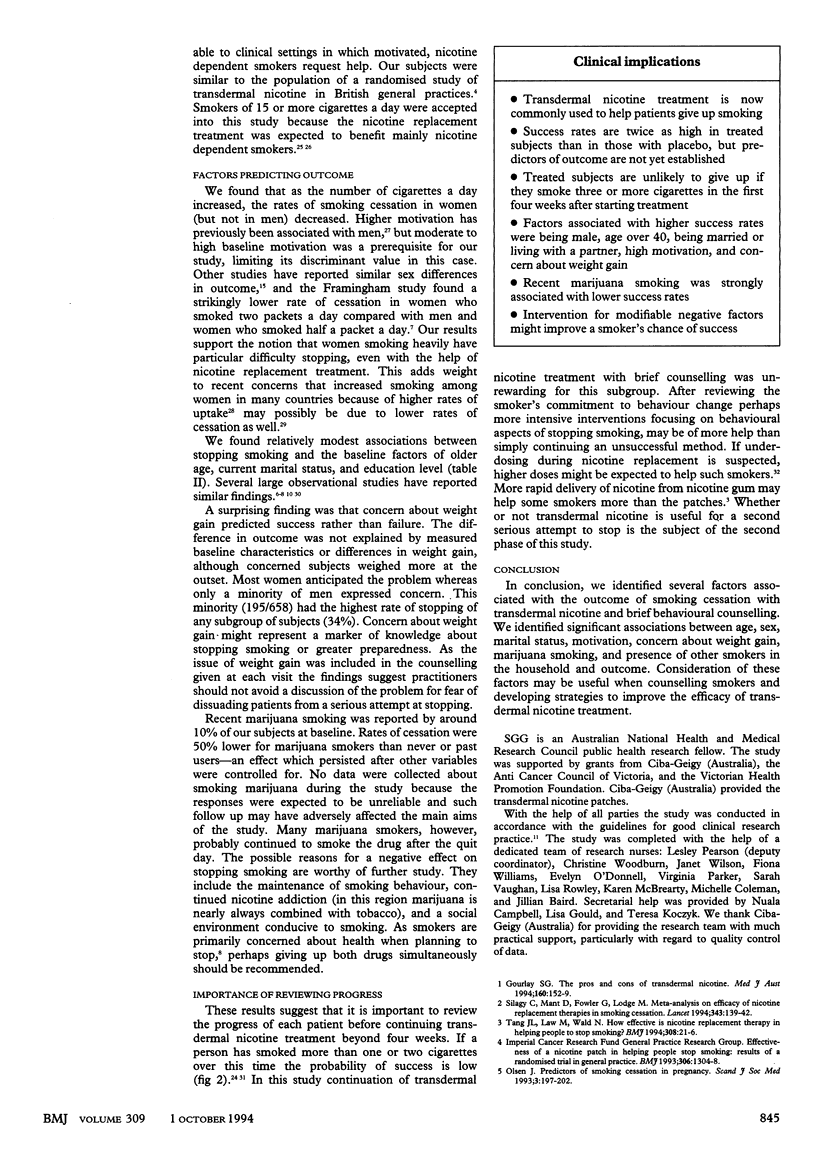
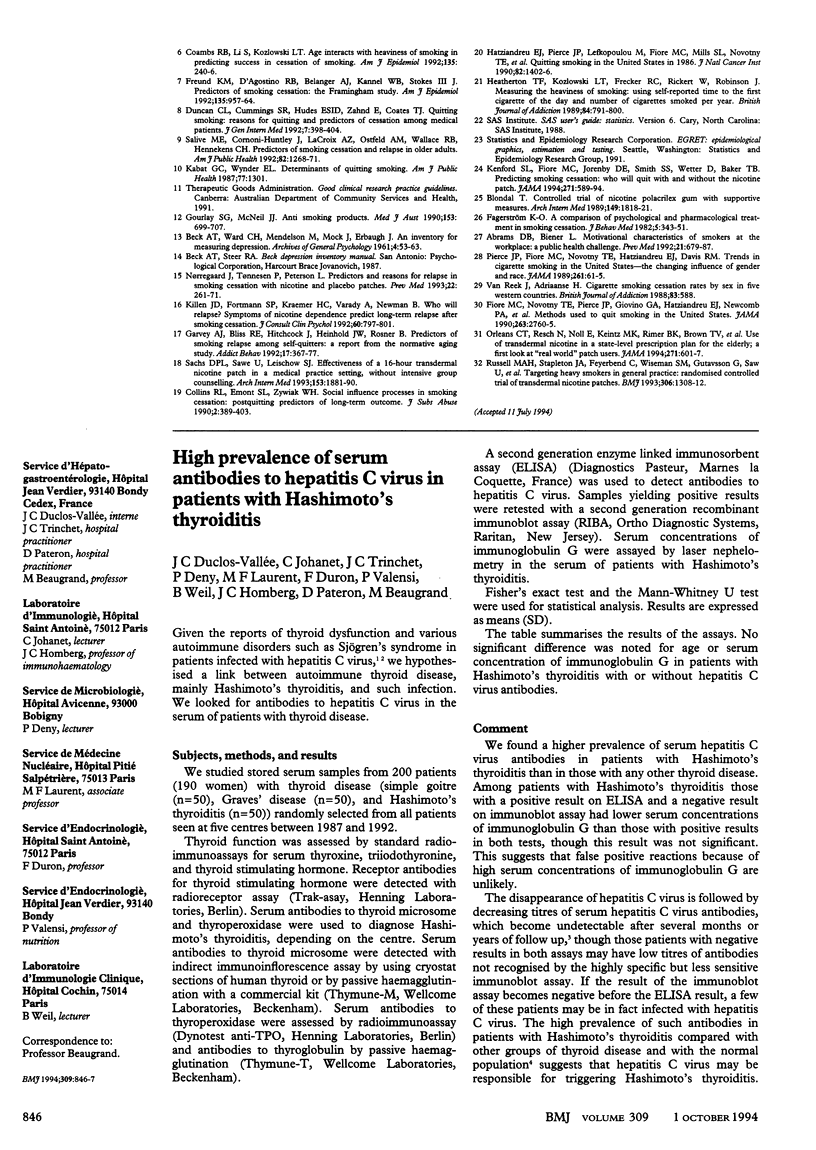
Selected References
These references are in PubMed. This may not be the complete list of references from this article.
- Abrams D. B., Biener L. Motivational characteristics of smokers at the workplace: a public health challenge. Prev Med. 1992 Nov;21(6):679–687. doi: 10.1016/0091-7435(92)90075-s. [DOI] [PubMed] [Google Scholar]
- Blöndal T. Controlled trial of nicotine polacrilex gum with supportive measures. Arch Intern Med. 1989 Aug;149(8):1818–1821. doi: 10.1001/archinte.1989.00390080080018. [DOI] [PubMed] [Google Scholar]
- Coambs R. B., Li S., Kozlowski L. T. Age interacts with heaviness of smoking in predicting success in cessation of smoking. Am J Epidemiol. 1992 Feb 1;135(3):240–246. doi: 10.1093/oxfordjournals.aje.a116277. [DOI] [PubMed] [Google Scholar]
- Collins R. L., Emont S. L., Zywiak W. H. Social influence processes in smoking cessation: postquitting predictors of long-term outcome. J Subst Abuse. 1990;2(4):389–403. doi: 10.1016/s0899-3289(12)80001-0. [DOI] [PubMed] [Google Scholar]
- Duncan C. L., Cummings S. R., Hudes E. S., Zahnd E., Coates T. J. Quitting smoking: reasons for quitting and predictors of cessation among medical patients. J Gen Intern Med. 1992 Jul-Aug;7(4):398–404. doi: 10.1007/BF02599155. [DOI] [PubMed] [Google Scholar]
- Fagerström K. O. A comparison of psychological and pharmacological treatment in smoking cessation. J Behav Med. 1982 Sep;5(3):343–351. doi: 10.1007/BF00846161. [DOI] [PubMed] [Google Scholar]
- Fiore M. C., Novotny T. E., Pierce J. P., Giovino G. A., Hatziandreu E. J., Newcomb P. A., Surawicz T. S., Davis R. M. Methods used to quit smoking in the United States. Do cessation programs help? JAMA. 1990 May 23;263(20):2760–2765. [PubMed] [Google Scholar]
- Freund K. M., D'Agostino R. B., Belanger A. J., Kannel W. B., Stokes J., 3rd Predictors of smoking cessation: the Framingham Study. Am J Epidemiol. 1992 May 1;135(9):957–964. doi: 10.1093/oxfordjournals.aje.a116407. [DOI] [PubMed] [Google Scholar]
- Garvey A. J., Bliss R. E., Hitchcock J. L., Heinold J. W., Rosner B. Predictors of smoking relapse among self-quitters: a report from the Normative Aging Study. Addict Behav. 1992;17(4):367–377. doi: 10.1016/0306-4603(92)90042-t. [DOI] [PubMed] [Google Scholar]
- Gourlay S. G., McNeil J. J. Antismoking products. Med J Aust. 1990 Dec 3;153(11-12):699–707. doi: 10.5694/j.1326-5377.1990.tb126327.x. [DOI] [PubMed] [Google Scholar]
- Gourlay S. The pros and cons of transdermal nicotine therapy. Med J Aust. 1994 Feb 7;160(3):152–159. [PubMed] [Google Scholar]
- Hatziandreu E. J., Pierce J. P., Lefkopoulou M., Fiore M. C., Mills S. L., Novotny T. E., Giovino G. A., Davis R. M. Quitting smoking in the United States in 1986. J Natl Cancer Inst. 1990 Sep 5;82(17):1402–1406. doi: 10.1093/jnci/82.17.1402. [DOI] [PubMed] [Google Scholar]
- Heatherton T. F., Kozlowski L. T., Frecker R. C., Rickert W., Robinson J. Measuring the heaviness of smoking: using self-reported time to the first cigarette of the day and number of cigarettes smoked per day. Br J Addict. 1989 Jul;84(7):791–799. doi: 10.1111/j.1360-0443.1989.tb03059.x. [DOI] [PubMed] [Google Scholar]
- Kabat G. C., Wynder E. L. Determinants of quitting smoking. Am J Public Health. 1987 Oct;77(10):1301–1305. doi: 10.2105/ajph.77.10.1301. [DOI] [PMC free article] [PubMed] [Google Scholar]
- Kenford S. L., Fiore M. C., Jorenby D. E., Smith S. S., Wetter D., Baker T. B. Predicting smoking cessation. Who will quit with and without the nicotine patch. JAMA. 1994 Feb 23;271(8):589–594. doi: 10.1001/jama.271.8.589. [DOI] [PubMed] [Google Scholar]
- Killen J. D., Fortmann S. P., Kraemer H. C., Varady A., Newman B. Who will relapse? Symptoms of nicotine dependence predict long-term relapse after smoking cessation. J Consult Clin Psychol. 1992 Oct;60(5):797–801. doi: 10.1037//0022-006x.60.5.797. [DOI] [PubMed] [Google Scholar]
- Nørregaard J., Tønnesen P., Petersen L. Predictors and reasons for relapse in smoking cessation with nicotine and placebo patches. Prev Med. 1993 Mar;22(2):261–271. doi: 10.1006/pmed.1993.1021. [DOI] [PubMed] [Google Scholar]
- Olsen J. Predictors of smoking cessation in pregnancy. Scand J Soc Med. 1993 Sep;21(3):197–202. doi: 10.1177/140349489302100309. [DOI] [PubMed] [Google Scholar]
- Orleans C. T., Resch N., Noll E., Keintz M. K., Rimer B. K., Brown T. V., Snedden T. M. Use of transdermal nicotine in a state-level prescription plan for the elderly. A first look at 'real-world' patch users. JAMA. 1994 Feb 23;271(8):601–607. [PubMed] [Google Scholar]
- Pierce J. P., Fiore M. C., Novotny T. E., Hatziandreu E. J., Davis R. M. Trends in cigarette smoking in the United States. Projections to the year 2000. JAMA. 1989 Jan 6;261(1):61–65. [PubMed] [Google Scholar]
- Russell M. A., Stapleton J. A., Feyerabend C., Wiseman S. M., Gustavsson G., Sawe U., Connor P. Targeting heavy smokers in general practice: randomised controlled trial of transdermal nicotine patches. BMJ. 1993 May 15;306(6888):1308–1312. doi: 10.1136/bmj.306.6888.1308. [DOI] [PMC free article] [PubMed] [Google Scholar]
- Sachs D. P., Säwe U., Leischow S. J. Effectiveness of a 16-hour transdermal nicotine patch in a medical practice setting, without intensive group counseling. Arch Intern Med. 1993 Aug 23;153(16):1881–1890. [PubMed] [Google Scholar]
- Salive M. E., Cornoni-Huntley J., LaCroix A. Z., Ostfeld A. M., Wallace R. B., Hennekens C. H. Predictors of smoking cessation and relapse in older adults. Am J Public Health. 1992 Sep;82(9):1268–1271. doi: 10.2105/ajph.82.9.1268. [DOI] [PMC free article] [PubMed] [Google Scholar]
- Silagy C., Mant D., Fowler G., Lodge M. Meta-analysis on efficacy of nicotine replacement therapies in smoking cessation. Lancet. 1994 Jan 15;343(8890):139–142. doi: 10.1016/s0140-6736(94)90933-4. [DOI] [PubMed] [Google Scholar]
- Tang J. L., Law M., Wald N. How effective is nicotine replacement therapy in helping people to stop smoking? BMJ. 1994 Jan 1;308(6920):21–26. doi: 10.1136/bmj.308.6920.21. [DOI] [PMC free article] [PubMed] [Google Scholar]
- Van Reek J., Adriaanse H. Cigarette smoking cessation rates by sex in five Western countries. Br J Addict. 1988 May;83(5):588–588. doi: 10.1111/j.1360-0443.1988.tb02580.x. [DOI] [PubMed] [Google Scholar]


